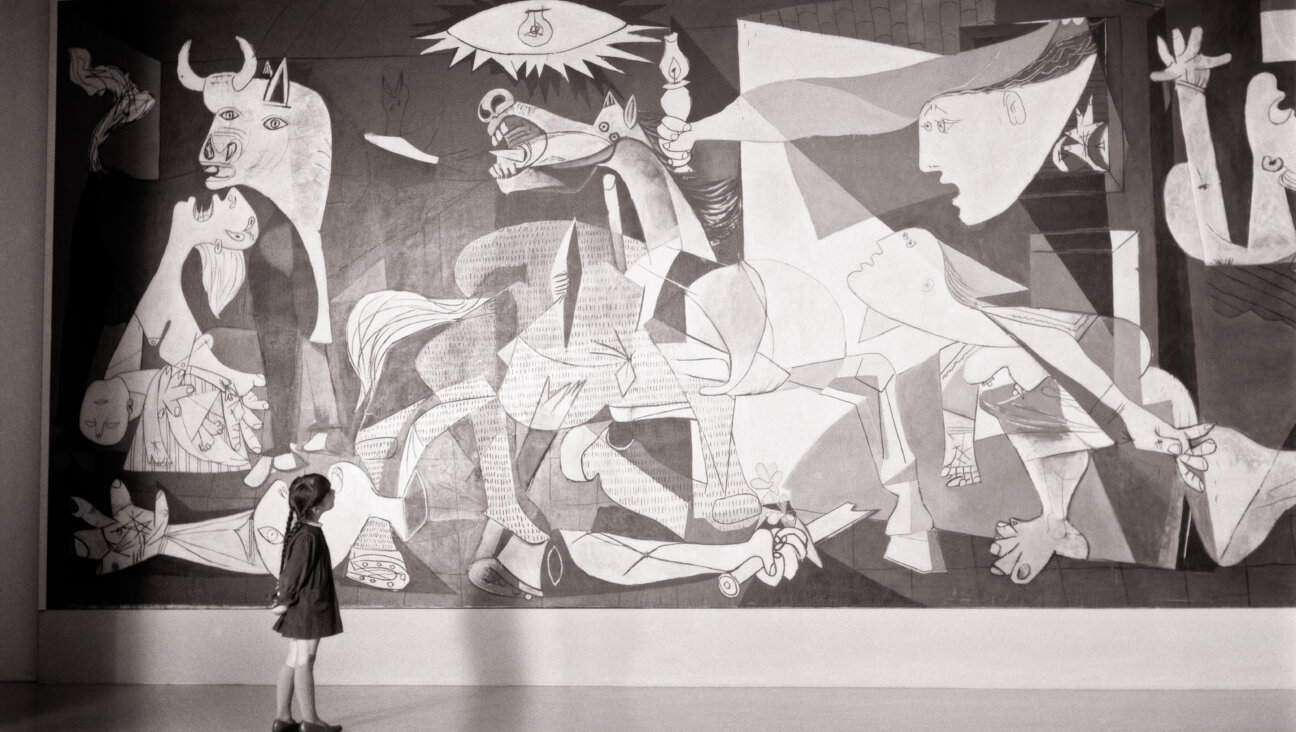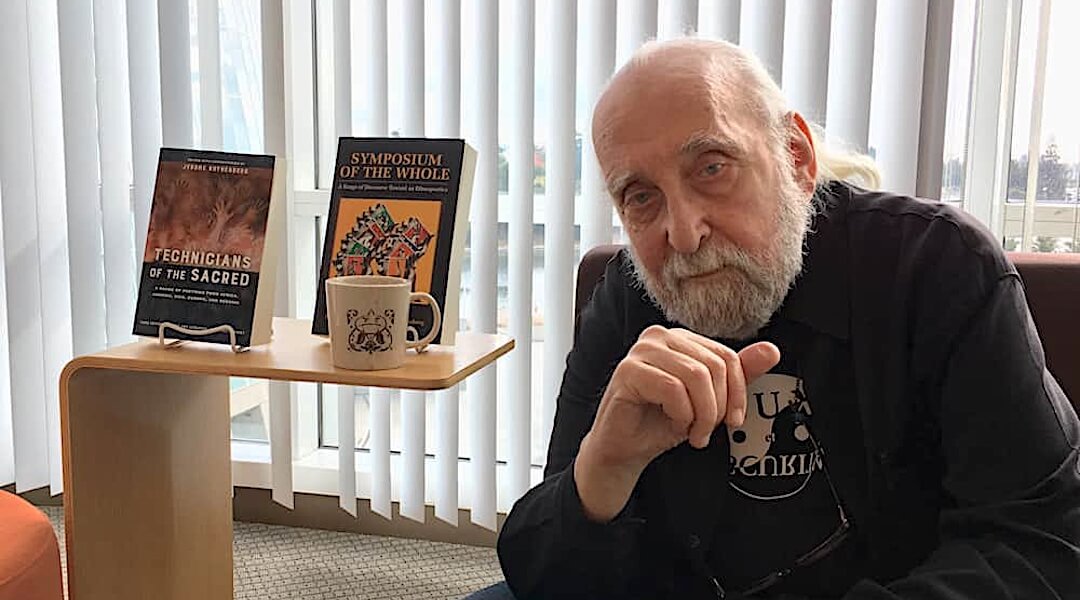Will the Real Sholem Aleichem Please Stand Up?

Promising Futures: Sholem Rabinovich, who adopted the name Sholem Aleichem, divided his time between writing and playing the stock market. Image by Forward Association
The Worlds of Sholem Aleichem: The Remarkable Life and Afterlife of the Man Who Created Tevye
By Jeremy Dauber
Schocken, 464 pages, $28.95
Wonder of Wonders: A Cultural History of ‘Fiddler on the Roof’
By Alisa Solomon
Metropolitan Books, 448 pages, $32.00
Like most Jews of my generation, I saw “Fiddler on the Roof” before I heard of Sholem Aleichem, and I saw the movie before I saw the musical. I can’t actually remember the first time I watched Chaim Topol stomping down that dusty road, snapping his fingers and belting “Tradition!” but I also can’t remember a point in time when I hadn’t seen him. I imagine it was one of those February snow days we had growing up in Winnipeg in the early 1990s, when my older sister and I would put on our snowsuits and trudge through carless streets to our little Jewish elementary school. Because half the students wouldn’t show up, we’d spend the day in darkened classsrooms, watching whatever movies the school library had on VHS. I’m pretty sure that “Fiddler” featured heavily in the rotation.
“Fiddler” was my first brush with Sholem Aleichem, but it wasn’t my last. One evening, when I was around 15 or so, I pulled a battered, blue-covered book called “The Old Country” off my parents’ shelf, where it was sandwiched between “A Treasury of Jewish Folkore” and a full set of “The History of Civilization” by Will and Ariel Durant. The book turned out to be a collection of Sholem Aleichem stories translated by Julius and Frances Butwin, a husband-and-wife team who had emigrated from Eastern Europe and had both landed in St. Paul, Minn. Published in 1946, the book impressed me as much with its own history as with the material between its covers. Though I didn’t learn the details until later, I intuited that “The Old Country” was not just a collection of stories by a turn-of-the-century Yiddish writer; it was, itself, an artifact of midcentury American Jewish life. The book didn’t just depict history; it was a piece of it, as well.
In the decades since “The Old Country” appeared, and since the 1964 Broadway debut of “Fiddler,” Sholem Aleichem has been thoroughly reevaluated, re-appreciated and re-translated. Scholars such as Dan Miron, Ruth Wisse and David Roskies have explicated the complexities of his work, and new translations have made the Butwins’ efforts, valuable though they were, largely redundant. But “The Old Country” was still an auspicious place to start. As my earlier encounter with “Fiddler” proved, it is almost impossible today — or at least, very unlikely — to experience Sholem Aleichem unmediated. He comes to us through the lenses of translation and adaptation, each reworking of his material reflecting the moment of its own creation. Even reading him in Yiddish, you can’t help but be aware of the later uses of his work. To put it another way, it’s hard to get “Fiddler” out of your head.
Depending on your taste in musical theater, “Fiddler’s” staying power could be evidence of its quality, or of its contamination of Sholem Aleichem’s legacy. Should fans of the writer thank the musical for making him famous, or condemn it for overshadowing his original stories? The question is raised by two new books, both of which support the first view, albeit with different emphases. “The Worlds of Sholem Aleichem: The Remarkable Life and Afterlife of the Man Who Created Tevye,” by the Columbia University Yiddish literature professor Jeremy Dauber, is a comprehensive biography — amazingly, the first in any language — that presents the writer’s legacy through the lens of his turbulent life. Though aimed at a general audience rather than at a scholarly one, it is a valuable resource for anyone interested in the life of the author. In contrast, “Wonder of Wonders: A Cultural History of ‘Fiddler on the Roof,’” by theater critic and Columbia journalism professor Alisa Solomon, takes Sholem Aleichem as context for its main subject. But both Dauber and Solomon are quick to point out that it’s impossible to talk about Sholem Aleichem without talking about “Fiddler” and it’s impossible to talk about “Fiddler” without talking about Sholem Aleichem. Rarely has there been an author so entangled with his creations, even, in this case, with one that isn’t his.
•
When Sholem Aleichem was in his mid-20s and living in Kiev, he used to summer with his family in Boyarka, a resort town about an hour outside the city. Boyarka boasted forests, fresh air, and door-to-door milk, cheese and butter delivery from a dairyman named Tevye. Sholem Aleichem enjoyed Tevye’s wares — he once wrote that the three things he loved most in life were newspapers, dairy foods and Jews — as well as his conversation, which he would jot down, amid chuckles, in his notebook. That fall, Tevye appeared as the subject of a two-part story called “Tevye the Dairyman — The Story of His Sudden Rise, Described by Tevye Himself and Dictated to Sholem Aleichem Word by Word.” Later revised as “The Jackpot” (or “Tevye Strikes It Rich,” in Hillel Halkin’s translation), the story begins:
“If you’re meant to strike it rich, Pani Sholem Aleichem, you may as well stay home with your slippers on, because good luck will find you there too. The more it blows the better it goes, as King David says in his Psalms — and believe me, neither brains nor brawn has anything to do with it. And vice versa… How does the saying go? Flogging a dead horse won’t make it run any faster.”
That voice, with its jokes, arguments, and attempts to deal with a crumbling world, helped make Sholem Aleichem famous, and made its real-life counterpart famous as well. Some 30 years later, a Soviet theater troupe visiting Boyarka was so impressed by meeting Tevye that the actors bought him a new cart and dairy equipment.
In the “Tevye” stories, Sholem Aleichem’s character is aware that he is being used for material, and he is sensitive about his portrayal. A few times he asks the author not to write about him, and if he does write something, to leave out his name. Today, in contrast, it’s Sholem Aleichem who is on the receiving end of the fame reflected by his character, and more because of Tevye’s appearance on Broadway than because of his role in Yiddish fiction. (There’s a reason, after all, that Dauber’s book references Tevye in its subtitle.) But if anyone would be amused by the ironies of Sholem Aleichem’s posthumous career, it would probably be Sholem Aleichem himself.
In his autobiography, “From the Fair,” which he wrote in the final years of his life, Sholem Aleichem portrayed himself as a troublemaker since childhood — “the greatest rascal in the family” — and especially gifted at imitating adults. His first attempt at writing, he claimed, was a dictionary of curses derived from his stepmother’s vocabulary. But Sholem Aleichem’s literary playfulness went beyond mimicry (though his work does display an exceptional talent for imitating human speech), or even late-life attempts to plant the seeds of his own mythology. Through an elaborate series of pseudonyms, characters and literary conceits, he created a fictional universe that not only convinced readers of its own reality, but succeeded in invading actual reality, as well. If an author attempted similar games today we would call them postmodern, and perhaps dismiss them for being too obvious about it. But coming before modernism, let alone postmodernism, Sholem Aleichem’s meta-fictional tricks seem more like natural outpourings of creativity than attempts to make theoretical points. And they started with his own name.
Sholem Aleichem in America from Jewish Daily Forward on Vimeo.
•
In 1883, a few years before he met Tevye, Sholem Rabinovich was a 24-year-old crown rabbi in Lubny, an ancient city in the Poltava province of Ukraine. (The position, imposed on the Jewish community by the czarist government, was more of an administrative post than a religious one.) He had recently married Olga Loyev, the daughter of a wealthy Jewish landowner and a former student from his years as a private tutor. In 1885 he would inherit his father-in-law’s estate and move to a luxurious apartment in Kiev, where he split his time between playing the stock market and writing at his custom-built standing desk. He also used his fortune to publish a new journal of Yiddish literature — Di yidishe folks-bibliotek — and to upgrade his wardrobe, adopting a pince-nez and pocket-watch to complement a Vandyke beard and jaw-length hair, which he wore swept back over his head.
In the following decades Sholem Aleichem would go bankrupt, survive a pogrom, flee the Russian Empire, and move to America, Switzerland and Italy, where he went to treat the tuberculosis that ultimately contributed to his death. He would also become one of the most popular and prolific Yiddish authors, whose 28 volumes of collected works cover barely half of his total writing. But in 1883 he was just starting out as a contributor to the Yudishes folks-blat, a weekly Yiddish newspaper published in St. Petersburg. Perhaps because of his job as crown rabbi, and perhaps because writing in Yiddish — so-called “jargon” — was not yet respectable, Rabinovich chose to use a pseudonym rather than his real name. When he wrote a story called “The Election,” about the election of a crown rabbi like himself, he signed it “Sholem Aleichem.”
In retrospect, critics have read various meanings into the phrase, including, as Alfred Kazin put it, “the sweet familiarity, the informality, the utter lack of side, that was associated with the Yiddish-speaking masses of Eastern Europe.” More convincing is Miron’s assertion that the name — meaning, roughly, “How do you do?” — was simply “absurd.” But even without any real significance, “Sholem Aleichem” took on a life of his own. Over the course of Sholem Aleichem’s career the moniker became not just a pseudonym but also a persona, and even a character in the stories themselves. He encouraged readers to identify him as Sholem Aleichem, and his own friends started calling him by that name rather than by his own. The title became so important to his identity that, as Miron writes, he couldn’t have gotten rid of it even if he had wanted to. As time went on, Sholem Rabinovich was replaced completely by Sholem Aleichem, his more famous alter ego.
The substitution of a literary persona for a flesh-and-blood person wasn’t Sholem Aleichem’s only ruse. His work, like that of other authors of the period, first appeared in the press before being published in book form. But unlike writers such as Dickens, who serialized entire novels from beginning to end, Sholem Aleichem mostly wrote linked sets of stories over long periods of time, with different parts appearing in different publications. Some of his best-known works include the Menakhem Mendl stories, epistolary works about a ne’er-do-well financial speculator and his long-suffering wife (published between 1887 and 1913); the Railroad Stories, in which an anonymous narrator recounts tales heard while traveling third class (published in 1902-3 and 1909-10), and “Motl, Peysi the Cantor’s Son,” the story of an orphan who travels with his mother and older brother to America from a shtetl in Europe (published in 1906-07 and 1915-16). But no matter where or how far apart the installments appeared, Sholem Aleichem managed to imbue his tales with a sense of their own reality, and the feeling that he had just come along to tell you about them.
This was especially true of the “Tevye” stories, which first appeared in 1884 in Der Hoyz-fraynd, a Warsaw periodical, and continued for almost 20 years. In this series, Sholem Aleichem became a character himself, as the listener to whom Tevye pours out his troubles. Tevye, of course, was inspired by a real person (though the events and details of his life are fictional), as was the wealthy Brodsky, who was a sugar merchant in Kiev. Complicating matters further was the appearance in one story of Menakhem Mendl, who swindles Tevye out of his savings. (Menakhem Mendl showed up in extra-literary contexts, as well. A wealthy fan of Sholem Aleichem once wrote a letter to the character, asking which political ideology to support. Sholem Aleichem responded, as Menakhem Mendl, advising the letter writer to become a patron of the arts and help the author Sholem Aleichem buy back his copyrights.) Dauber draws an analogy here to the Marvel comic book universe, where the hero of one series will show up in another hero’s adventure. As with Dauber’s other pop-culture references (“Seinfeld,” Oprah Winfrey and Chris Rock all get mentioned) the analogy isn’t really necessary, but it makes the relevant point.
Most important to this through-the-looking-glass effect was the fact that Tevye’s adventures took place in real time. Over the course of the stories, Tevye gains a fortune, loses it and suffers through his daughters’ escalating series of nontraditional marriages. In the end, he is exiled by czarist edict from his home, where he has lived his entire life. But unlike “Fiddler on the Roof,” which is set within a relatively short time frame, Tevye grows older in the stories by the same interval it took for each installment to be published. Whenever Sholem Aleichem sat down to write a new episode, the character had lived through whatever world events had occurred since the last one. It was no wonder that so many readers saw their lives reflected in the stories, or that Sholem Aleichem came to be considered a writer of, and for, the common people. Tevye was their beleaguered milkman, and Sholem Aleichem a sympathetic neighbor.
If Sholem Aleichem did want his readers to take his stories as something more than fiction, he was more successful than he knew. On May 13, 1916, Sholem Aleichem died in the Bronx at age 57, having finally succumbed to tuberculosis and diabetes. Two days later, upward of 150,000 mourners packed the streets of New York in the largest funeral the city had ever seen. The author was hardly in the ground before he was appropriated as a symbol not of literary artistry, but of artless authenticity. The Hebrew writer Yosef Haim Brenner declared him to be “a living essence of the folk itself” who “had no style” and “had no need of style.” Maurice Samuel, a later adapter and popularizer of Sholem Aleichem in English, wrote that it is “hard to think of him as a ‘writer’” but his work provided “as reliable a scientific document [of the Russian-Jewish Pale] as any ‘factual study.’” Perhaps, as a mimic, Sholem Aleichem had succeeded too well. Perhaps some of his meta-fictional tricks had been taken too seriously. Most likely, his readers wanted a link to a swiftly disappearing past, and decided that he was the best fit. If that meant overlooking other aspects of his work, then so be it.
•
By the time the original Broadway production of “Fiddler on the Roof” closed on July 2, 1972, almost eight years after it opened, the musical had run for a record-breaking 3,242 performances, won nine Tony Awards and earned about $1,574 for every dollar invested. To date there have been four Broadway revivals, productions in countries from Israel to Japan and, according to Solomon’s estimate, around 200 school performances each year. All of this makes “Fiddler” the most famous version of Sholem Aleichem’s stories, and certainly the most successful.

Chaim Topol performs as Tevye in a 2005 Australian production of ?Fiddler on the Roof.? Image by Getty Images
“Fiddler,” hasn’t been the only adaptation of Sholem Aleichem, however. The author himself rewrote his “Tevye” stories for the stage, though the play wasn’t produced until 1919, when Maurice Schwartz premiered “Tevye der milkhiker” (“Tevye the Dairyman”) on Second Avenue. (In 1939, Schwartz also made “Tevye” into a movie, which he shot in Jericho, Long Island.) The most significant pre-“Fiddler” stage production of Sholem Aleichem’s work was the English-language “The World of Sholem Aleichem,” created in 1953 by two blacklisted artists, Arnold Perl and Howard Da Silva. Only a portion of the play was actually based on Sholem Aleichem, and even there Perl and Da Silva introduced some transparent leftist sloganeering. (Though Sholem Aleichem was sympathetic to the socialist left, and occasionally enthusiastic about revolutionary ideas, his only consistent political cause was Zionism, which he supported throughout his life.) But “The World of Sholem Aleichem” was hugely popular, and ran for 306 performances.
For some critics, however, Perl and Da Silva’s play was guilty not just of politicizing its source, but of misrepresenting Eastern European Jewry altogether. Midge Decter, writing in Commentary Magazine, accused it of fabricating “just the kind of Never-Never-Land American Jews like to think they came from, quaint, not quite respectable, but abounding with a special sweetness.” It was guilty of making the shtetl into “a new Jewish folk tradition,” she wrote, for a community that “can afford to be pleased by the ghetto. Here is the Jewish past as we like to think it. Here is Jewish culture as well-meaning friends like to understand it. Sweet and simple…. The ghetto is sufficiently dead in us by now to become a serene source of ageless wisdoms.”
Decter’s vitriol was just a warm-up for the attacks that would greet “Fiddler” nine years later. Irving Howe, also writing in Commentary, called the show’s creative team hacks, the music “flat chested” and the choreography “so slick as finally to be sterile.” The staged pogrom, he said, was “papier-maché” and the candle-lighting scene (featuring the song “Sabbath Prayer”) the equivalent of “Shabbos at Radio City Music Hall.” Even Zero Mostel, whose portrayal of Tevye was praised elsewhere, “bears down” on his lines “with a crushing weight,” while God is turned into his “straight man.” And as Decter had done, Howe accused “Fiddler” of romanticizing Jewish history by creating “the cutest shtetl we never had.”
Solomon, who was a theater critic at the Village Voice for 21 years before becoming a journalism professor at Columbia University, dismisses such fault-finding, calling Howe’s piece “famously cranky,” another review “cantankerous,” and labeling all such critics “highbrow scolds.” In contrast, she celebrates “Fiddler” as a groundbreaking work of musical theater, and she provides an illuminating and detailed history of its production. Among other tidbits, we learn that director Jerome Robbins went to Hasidic weddings in Brooklyn to research the choreography, and that set designer Boris Aronson had worked on Shwartz’s 1929 production of another Sholem Aleichem play, “Stempenyu.” Though “Fiddler” was accused of historical inaccuracy, the costume designer, Patricia Zipprodt, insisted on using only materials that would have been available in 1905, the year the action was set.
Most important, Solomon defends “Fiddler” against the charge of sentimentalism, arguing that the production rejected the kind of Second Avenue or Borscht Belt comedy that had created the cutesy shtetl long before “Fiddler” arrived on the scene. The musical’s creators turned away actors who arrived with “Old Country accents, flailing hands, or singsong intonations” and “labored mightily to burn away the schmaltz that for two decades had encased the world of the shtetl like amber.” I don’t know if that makes “Fiddler” hard-headed, but there’s merit to the idea that it was an improvement on something worse.
Even if you agree that “Fiddler” was a masterpice, however, Solomon doesn’t really give its critics their due. As she readily states, the popularity of “Fiddler” “burdened it with extra-theatrical responsibilities,” including the task of representing American Jewry’s Eastern European past. In response, Solomon argues that expecting a Broadway musical to realistically portray a historical place is ridiculous. “Musicals always unfold in fake places,” she writes. “No one looks for documentary realism in the New York City of ‘Guys and Dolls’ or ‘West Side Story.’” But she concedes that audiences did look to “Fiddler” for documentary witness, just as they had looked to the works of Sholem Aleichem himself. This was especially true after of the Holocaust, when there was no longer an Old World to go back to. When the Butwins’ volume of translations was published just a year after the war, Ben Hecht, in his New York Times review, called it “the epitaph of a vanished world and an almost vanished people.” Even Molly Picon, the Yiddish actress who played Yente in the 1971 film version of “Fiddler,” claimed: “This is like a document of historical significance… It’s part of a world that’s gone.”
The debate also wasn’t just about whether “Fiddler” got the details of the shtetl right — it was a fight over the soul of America Jewish culture. Here, Solomon and “Fiddler” critics aren’t so much in disagreement as they occupy different points of view. Solomon, coming after the fact, looks at the Jewish reaction from a detached perspective, observing it as an anthropological reality rather than a position to be argued with. For critics like Howe, who were writing contemporaneously and from within the Jewish sphere, the audience was an object of criticism as much as the musical itself. Part of the triumph of “Fiddler,” according to Solomon, was its embrace by a community that had spent decades denying, ignoring or otherwise trying to cover up its immigrant past. The musical, in her reading, provided a way for them to reengage with that past on comfortable and even celebratory terms. But for critics who had been decrying the same tendency for decades, the moment was less a triumph than a compounding of tragedy. When the Jewish community finally decided to remember its heritage, it turned to a Broadway musical that, in Solomon’s own view, shouldn’t have been counted on to represent a real place. It may have been a great show, but it could hardly replace thousands of years of history.
•
These days, if the soul of American Jewry seems a little more secure, that’s because “Fiddler” wasn’t the only source of connection for everyone, any more than Sholem Aleichem had been. But in the 1960s, the culture that had been so thoroughly destroyed in the Holocaust did seem in danger of being lost for good. Thus “Fiddler,” in the role of rescuer, took on a burden that it never should have had, but one that was also largely responsible for its success. Now, with academic programs in Yiddish at universities around the world, more scholarship being produced on Eastern European Jewish history than anyone could ever read, and a religious revival that makes Tevye’s observance seem less exotic, the stakes are a lot lower. Nobody needs “Fiddler” to connect with the past anymore. At the same time, these resources are there only for those who want them. For many people, “Fiddler” is still representative of the Yiddish world, and that is still a problem. When your culture is chiefly represented by a Broadway show, it’s bad news.
One can hope that books like Dauber’s and Solomon’s will make the history behind “Fiddler” known to a wider public, and that “Fiddler” will be free to be the work of musical theater that it is, rather than the cultural avatar it became. But as Solomon describes, “Fiddler” itself has assumed its own strange afterlife, just as Sholem Aleichem did. In a neat little irony, “Fiddler,” which was so often accused of not being the real article, has become a source of folk culture. Just as Sholem Aleichem’s stories were assumed to be traditional, so the songs and dances in “Fiddler” have become part of Jewish ritual. And just as “Fiddler” was originally accused of watering down its source, so a 2004 Broadway revival was charged with making the musical less Jewish. It was, you might say, accused of misrepresenting the midcentury way of representing the early 20th-century Jewish past.
To be honest, I don’t care for “Fiddler” all that much, despite Solomon’s persuasiveness. And there are plenty of writers I prefer to Sholem Aleichem, though he is one of the greats. But as Louis Armstrong once said: “All music is folk music. I ain’t never heard a horse sing a song.” Here, too, Sholem Aleichem and “Fiddler” are both part of Jewish folk culture, whether as literature or theater or sets of Tevye and Golde salt and pepper shakers. My school’s VHS tape of the movie, if it still exists, is as much a relic of 20th-century Jewish culture as my parent’s copy of “The Old Country” or my own set of Sholem Aleichem’s complete works, published by the Forverts in 1942. What I enjoy or how much is beside the point — all of them are part of the culture I live in, and feel like they always have been. And maybe that’s the highest complement you could pay to Sholem Aleichem or “Fiddler,” or any of the works they inspired. It’s hard to imagine life without them.
Ezra Glinter is the deputy arts editor of the Forward. Follow him on Twitter, @EzraG

I hope you appreciated this article. Before you go, I’d like to ask you to please support the Forward’s award-winning, nonprofit journalism during this critical time.
Now more than ever, American Jews need independent news they can trust, with reporting driven by truth, not ideology. We serve you, not any ideological agenda.
At a time when other newsrooms are closing or cutting back, the Forward has removed its paywall and invested additional resources to report on the ground from Israel and around the U.S. on the impact of the war, rising antisemitism and the protests on college campuses.
Readers like you make it all possible. Support our work by becoming a Forward Member and connect with our journalism and your community.
Make a gift of any size and become a Forward member today. You’ll support our mission to tell the American Jewish story fully and fairly.
— Rachel Fishman Feddersen, Publisher and CEO
Join our mission to tell the Jewish story fully and fairly.
























